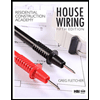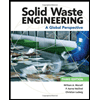
Concept explainers
In a work situation where an electrician’s hands get wet while operating a 120-volt, corded drill, which of the following would be true? (Objective 1-1)
a. Body resistance increases, and any shock would be mild.
b. Body resistance remains the same, and there is no danger as Long as rubber boots are worn.
c. Body resistance is substantially decreased, and severe shock could occur.
d. There is no danger as Long as a three-prong plug is used.
The true statement for the situation where an electrician’s hands get wet while operating a
Answer to Problem 1RQ
Option (c) Body resistance is substantially decreased, and severe shock could occur.
Explanation of Solution
Introduction:
According to the Ohm’s law, the relation between the current, voltage, and resistance is given by,
Here, the current is in amperes, voltage is in volts, and resistance is measured in Ohm’s.
The flow of current through any material depends upon the resistance provided by the material. The higher is the circuit resistance, the lower the current flow that a voltage can push through the circuit and vice-versa.
Dry skin offers much more resistance in comparison to the wet body. This means that higher the resistance value, the more opposition to the current flow through the body.
The following table shows the value of resistance with respect to the different conditions:
| Skin Condition | Resistance |
| Dry skin | |
| Sweaty hands | |
| In water |
As shown in the above table, the value of resistance for wet hands is very less so if in a work situation where an electrician’s hands get wet while operating a
As shown in the above table, the value of resistance for wet hands is very less, so the shock will not be mild. Thus, option (a) is incorrect.
Therefore, the body resistance will not remain the same if the hand gets wet. Thus, option (b) is incorrect.
The electrician will always be in danger if his hands are wet. Thus, option (d) is incorrect.
Conclusion:
Therefore, the Option (c) Body resistance is substantially decreased, and severe shock could occur is best suitable answer for the given statement.
Want to see more full solutions like this?
Chapter 1 Solutions
Residential Construction Academy: House Wiring (MindTap Course List)
- Show step by step solutionarrow_forwardDraw the shear and the moment diagrams for each of the frames below. If the frame is statically indeterminate the reactions have been provided. Problem 1 (Assume pin connections at A, B and C). 30 kN 2 m 5 m 30 kN/m B 60 kN 2 m 2 m A 22 CO Carrow_forwardThis is an old exam practice question. The answer key says the answer is Pmax = 52.8kN but I am confused how they got that.arrow_forward
- F12-45. Car A is traveling with a constant speed of 80 km/h due north, while car B is traveling with a constant speed of 100 km/h due east. Determine the velocity of car B relative to car A. pload Choose a File Question 5 VA - WB VBA V100 111413 + *12-164. The car travels along the circular curve of radius r = 100 ft with a constant speed of v = 30 ft/s. Determine the angular rate of rotation è of the radial liner and the magnitude of the car's acceleration. Probs. 12-163/164 pload Choose a File r = 400 ft 20 ptsarrow_forwardPlease show step by step how to solve this and show formulararrow_forwardPlease solve this question step by step with dia gramarrow_forward
- Use the second picture to answer the question, Thank you so much for your help!arrow_forwardP6.16 A compound shaft (Figure P6.16) consists of a titanium alloy [G= 6,200 ksi] tube (1) and a solid stainless steel [G= 11,500 ksi] shaft (2). Tube (1) has a length L₁ = 40 in., an outside diameter D₁ = 1.75 in., and a wall thickness t₁ = 0.125 in. Shaft (2) has a length 42 = 50 in. and a diameter d₂ = 1.25 in. If an external torque TB = 580 lb ft acts at pulley B in the direction shown, calculate the torque Tcrequired at pulley C so that the rotation angle of pulley Crelative to A is zero. B Te (2) TB (1) FIGURE P6.16arrow_forward7.43 Neglecting head losses, determine what horsepower the pump must deliver to produce the flow as shown. Here, the elevations at points A, B, C, and D are 124 ft, 161 ft, 110 ft, and 90 ft, respectively. The nozzle area is 0.10 ft². B Nozzle Water C Problem 7.43arrow_forward
- A 1.8m x 1.8m footing is located at a depth of 1 m below the ground surface in a deep deposit of compacted sand (f'= 33 , f' = 28 , γ = 17.5 kN/m). Calculate the ultimate net bearing capacity considering several factors (e.g., shape, depth, and inclination) when the groundwater table is located (a) at 5 m below the footing base, (b) at the ground surface, (c) at the footing base, and (d) at 1.5 m below the footing base. Also, explain the effects of the groundwater levels in the bearing capacities of the footing with your own words. If the information is not given for the calculation, please assume it reasonably.arrow_forward7.18 Determine the discharge in the pipe and the pressure at point B. Neglect head losses. Assume α = 1.0 at all locations. 1.5 m Water B 3.5 m 40 cm diameter -20 cm diameter nozzle Problem 7.18arrow_forwardA 200-lb block is at rest on a 30° inclined plane. The coefficient of friction between the block and the inclined plane is 0.20. Compute the value of a horizontal force P that will cause motion to impend the block up the inclined plane. 200 lb P 30°arrow_forward
 Residential Construction Academy: House Wiring (M...Civil EngineeringISBN:9781337402415Author:Gregory W FletcherPublisher:Cengage Learning
Residential Construction Academy: House Wiring (M...Civil EngineeringISBN:9781337402415Author:Gregory W FletcherPublisher:Cengage Learning Solid Waste EngineeringCivil EngineeringISBN:9781305635203Author:Worrell, William A.Publisher:Cengage Learning,
Solid Waste EngineeringCivil EngineeringISBN:9781305635203Author:Worrell, William A.Publisher:Cengage Learning,

